Related Research Articles

Sterling County is a county located on the Edwards Plateau in the U.S. state of Texas. As of the 2020 census, its population was 1,372, making it the ninth-least populous county in Texas. Its county seat is Sterling City. The county is named for W. S. Sterling, an early settler in the area. Sterling County was one of 30 prohibition, or entirely dry, counties in the state of Texas, but is now a moist county.

The Calgary Stampede is an annual rodeo, exhibition, and festival held every July in Calgary, Alberta, Canada. The ten-day event, which bills itself as "The Greatest Outdoor Show on Earth", attracts over one million visitors per year and features one of the world's largest rodeos, a parade, midway, stage shows, concerts, agricultural competitions, chuckwagon racing, and First Nations exhibitions. In 2008, the Calgary Stampede was inducted into the ProRodeo Hall of Fame.

A cowboy is an animal herder who tends cattle on ranches in North America, traditionally on horseback, and often performs a multitude of other ranch-related tasks. The historic American cowboy of the late 19th century arose from the vaquero traditions of northern Mexico and became a figure of special significance and legend. A subtype, called a wrangler, specifically tends the horses used to work cattle. In addition to ranch work, some cowboys work for or participate in rodeos. Cowgirls, first defined as such in the late 19th century, had a less-well documented historical role, but in the modern world work at identical tasks and have obtained considerable respect for their achievements. Cattle handlers in many other parts of the world, particularly South America and Australia, perform work similar to the cowboy.

Transhumance is a type of pastoralism or nomadism, a seasonal movement of livestock between fixed summer and winter pastures. In montane regions, it implies movement between higher pastures in summer and lower valleys in winter. Herders have a permanent home, typically in valleys. Generally only the herds travel, with a certain number of people necessary to tend them, while the main population stays at the base. In contrast, horizontal transhumance is more susceptible to being disrupted by climatic, economic, or political change.

In agriculture, grazing is a method of animal husbandry whereby domestic livestock are allowed outdoors to roam around and consume wild vegetations in order to convert the otherwise indigestible cellulose within grass and other forages into meat, milk, wool and other animal products, often on land unsuitable for arable farming.
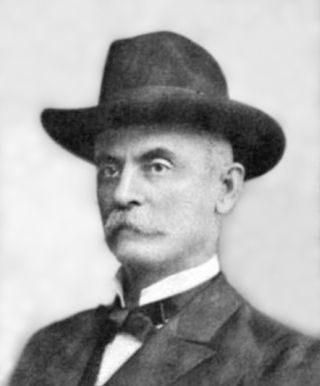
John Sparks was an American politician. He was the tenth Governor of Nevada, and was nicknamed Honest John. Like his predecessor, Reinhold Sadler, Sparks was a cattleman and his rise to political power was evidence of the decline of the mining industry and the rise of the ranching industry in Nevada. He was a member of the Silver – Democratic Party. In 1958, he was inducted into the Hall of Great Westerners of the National Cowboy & Western Heritage Museum.

Daryl Kenneth "Doc" Seaman was a Canadian oilman and hockey executive. Seaman was the founder, president, and chairman of Bow Valley Industries Limited, which was one of Canada's largest independent petroleum companies. In addition to his business activities, from 1941 to 1945 he served as a pilot in the Royal Canadian Air Force and from 1980 to 2009 was a part-owner of the Calgary Flames.
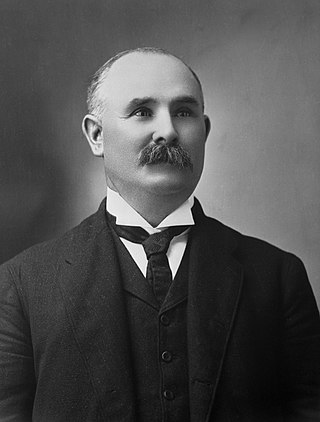
Patrick Burns was a Canadian rancher, meat packer, businessperson, senator, and philanthropist. A self-made man of wealth, he built one of the world's largest integrated meat-packing empires, P. Burns & Co., becoming one of the wealthiest Canadians of his time. He is honoured as one of the Big Four western cattle kings who started the Calgary Stampede in Alberta in 1912.
Pekisko is an unincorporated community in southern Alberta, Canada. It is located in the Foothills County, east of the junction of Cowboy Trail and Highway 540, 35 kilometres (22 mi) south of High River and 19 km (12 mi) south of Longview.

The Spade Ranch is a large cattle ranch located in the Sandhills of western Nebraska between the towns of Gordon and Ellsworth. Founded in 1888 by Bartlett Richards, the ranch was placed on the National Register of Historic Places in 1980.

The World Professional Chuckwagon Association (WPCA) is an association made up of professional cowboys and business people with an interest in preserving western heritage and providing family entertainment. The WPCA promotes and presents chuckwagon racing as a professional sport throughout North America and the world. The WPCA is a close-knit community that mentors its new drivers in safety and professionalism to preserve the integrity of the WPCA and chuckwagon racing in general.
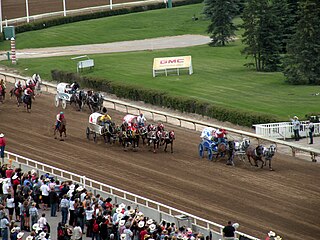
Chuckwagon racing is an equestrian rodeo sport in which drivers in a chuckwagon led by a team of Thoroughbred horses race around a track.
Riley Park is an urban park in Calgary, Alberta, Canada. It is located in the neighbourhood of Hillhurst, bounded by 8th Ave. NW, 10th St. NW, 5th Ave. NW and 12th St. NW. The park plays is host to Calgary's Cricket Leagues and Calgary Concert Band holds free concerts in the park during summer. Amenities include a wading pool and playground.

The Bar U Ranch National Historic Site, located near Longview, Alberta, is a preserved ranch that for 70 years was one of the leading ranching operations in Canada. At its peak, the ranch extended over 160,000 acres (65,000 ha) with 30,000 cattle and 1000 Percheron horses. Two owners were instrumental in the establishment of the Calgary Stampede, forming part of the Big Four.
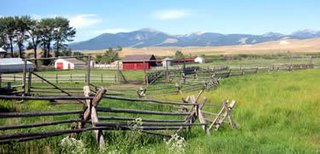
A ranch is an area of land, including various structures, given primarily to ranching, the practice of raising grazing livestock such as cattle and sheep. It is a subtype of a farm. These terms are most often applied to livestock-raising operations in Mexico, the Western United States and Western Canada, though there are ranches in other areas. People who own or operate a ranch are called ranchers, cattlemen, or stockgrowers. Ranching is also a method used to raise less common livestock such as horses, elk, American bison, ostrich, emu, and alpaca.

American Prairie is a prairie-based nature reserve in Central Montana being developed as a private project of the American Prairie Foundation (APF). This independent non-profit organization is creating a wildlife conservation area that aims to cover over 3 million acres (12,000 km2) through a combination of both private and public lands to establish a mixed grass prairie ecosystem with migration corridors and native wildlife.

In the Western United States and Canada, open range is rangeland where cattle roam freely regardless of land ownership. Where there are "open range" laws, those wanting to keep animals off their property must erect a fence to keep animals out; this applies to public roads as well. Land in open range that is designated as part of a "herd district" reverses liabilities, requiring an animal's owner to fence it in or otherwise keep it on the person's own property. Most eastern states and jurisdictions in Canada require owners to fence in or herd their livestock.

The Whitehorse Ranch is a historic cattle ranch in Harney and Malheur counties in the southeastern corner of Oregon, United States. The ranch was started in 1869 by John S. Devine, a well-known 19th-century cattle baron. It was originally the headquarters for the Todhunter and Devine Cattle Company. The ranch has been in the cattle business continuously since it was founded. Today, the Whitehorse Ranch includes 63,222 acres (255.85 km2) of deeded property and grazing rights on an additional 287,205 acres (1,162.28 km2) of public range land administered by the Bureau of Land Management.
Chase Ranch Cimarron, New Mexico was founded in 1867 by Manly and Theresa Chase. As pioneers, from Wisconsin by way of Colorado, they crossed the Raton Pass in a covered wagon and establish a new home in New Mexico. Manly Chase purchased the land from Lucien Maxwell, part of the Maxwell Land Grant. The ranch is near the Ponil Creek, a mile north of the Cimarron River, not far from the Santa Fe Trail. The Ranch included the old Kit Carson homestead. Before the arrival of pioneers, the land was populated by Apaches and Ute people. Manly provided the local Native Americans with beef, creating peaceful coexistence.
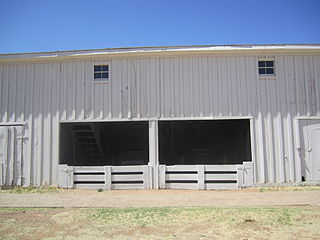
The U Lazy S Ranch, formerly known as the Square and Compass Ranch, is a historic ranch in Garza County, Texas, USA.
References
- ↑ "Gallery: Take a ride around the OH Ranch in Longview".
- 1 2 3 "OH Ranch Heritage Rangeland Management Plan" (PDF).
- ↑ "Producer Stories From Alberta Farms and Ranches" (PDF).
- ↑ "100 Year Birthday Gift: Philanthropist, rancher and businessman Bill Siebens gifts historic Alberta ranching property to the Calgary Stampede Foundation". Nanton News. 22 June 2012. Retrieved 30 Aug 2016.
- ↑ "EXPERIENCE EDUCATION AT THE OH RANCH".